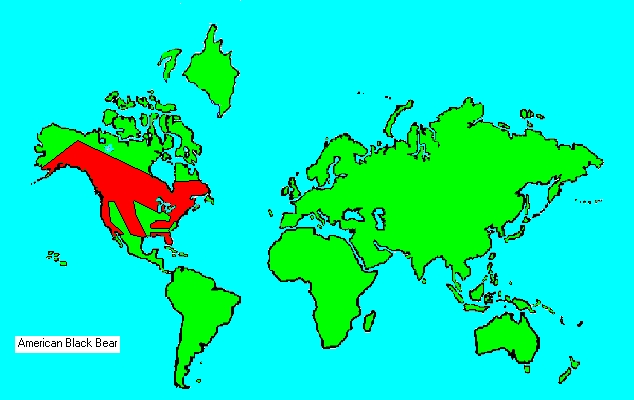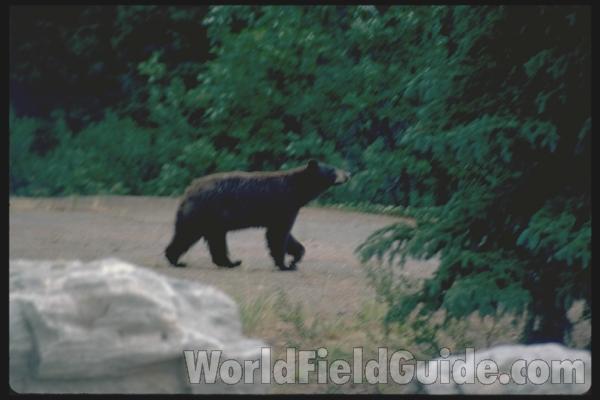SPECIES INFO
American Black Bear (Ursus americanus) is found from Mexico to Canada. Previously common throughout the United States, it is rare now except in the northern part of its range. A few wild examples live in the Ozark Mountains, the Rocky Mountains, Florida, and the Appalachians. Their diet consists of carrion, garbage, fruit, nuts, and insects. This bear can weigh up to almost 600 pounds.
MacDonald and Cook in their Alaskan Mammal Book published in 2009 noted that the Alaskan population of this lifeform was estimated to occur in the forested regions of the southern half of the state. This bear is considered common in the south central region of Alaska.Bear group (Family Ursidae) is found primarily in the Northern Hemisphere. (The Spectacled Bear is found from in Venezuela to Bolivia in the Andes. There are several species found in tropical Malaysia.) There are eight or nine or ten species in this family subject to the classification of the northern large brown bears.
Following is a partial list of some species:
SPECIES - - - - COMMON NAME - - - - LOCATION
Helarctos malayananus - (Malayan Sun Bear) - Burma, Sumatra, Borneo
Melursus ursinus - (Sloth Bear) - India, Sri Lanka
Selenarctos thibetanus - (Asian Black Bear) - China, Japan, Korea
Thalarctos maritimus - (Polar Bear) - Arctic Regions
Tremarctos ornatus - (Ucumari-Spectacled) - Andes (Venezuela to Bolivia)
Ursus americanus - (American Black Bear)- Central Mexico to Alaska
Ursus arctos arctos - (European Brown Bear) - Europe
Ursus arctos horribilis - (Grizzly Bear) - North America
Ursus arctos middendorfi - (Big Brown Bear) - Kodiak Island
Ursus spelaeus - (Europe Cave Bear) - Extinct
Carnivores (Order Carnivora) are found naturally worldwide, except for Australia which has an introduced wild dog. Carnivores are characterized by their habits of feeding on other animals. They usually can run quickly and capture their food with the help of their claws and jaws. Typical carnivores are dogs, cats, and bears.
Mammals (Class Mammalia), together with the birds, are among the youngest of the classes of animals. In species count, mammals number about fifty-one hundred, trailing reptiles (approximately fifty-five hundred), fish (approximately eighteen thousand), and birds (approximately eighty-six hundred).
There are three sub-types of mammals:
monotremes, the most primitive:
Develop in reptilian-like eggs and suckle milk emerging
(i.e., spiny anteater, duckbilled platypus)
marsupials
Newborn emerges very underdeveloped and continue to
mature in a pouch on its mother's abdomen (i.e., opossums,
koala, kangaroo)
placental
Embryo develops within the uterus of the female and is
dependent on a placenta for nutrition and waste removal
(i.e., humans, lions, monkeys)
About sixty-five million years ago, the Tertiary era produced thirty-five orders of mammals. Of this number, eighteen have survived to represent Earth's most diversified as well as its most highly developed classification of animals.
Extinction of mammals is fast becoming a serious issue. Duff and Lawson present a list of forty-one extinct species that reached extinction prior to 1800. These forty-one species are not acknowledged in the counts of the various families. Duff and Lawson also present a list of forty-six species including three gazelles, one zebra, one seal, one deer, and one wolf that have probably gone extinct since 1800. These forty-six species are included in the family counts. Science is adding about forty to fifty new species a year to the list. Many of these are the result of divisions of prior species; some are recent discoveries.
Mammals owe their survival to adaptive capabilities that include the ability to exploit whatever sources of food are available to them, as well as their ability to adjust to various climes. Food specialization influenced evolution to such a great extent that the teeth structure can and has been used to provide extensive information on the food needs and various lifestyles of extinct species.
Despite the vast diversity among mammals in terms of size, habitats and adaptations, they share without exception many characteristics such as:
a. body hair
b. mammary glands
c. certain skull characteristics
d. four limbs that permit speed
e. parallel not perpendicular limbs
f. compartmentalized internal organs
g. a four-chambered heart and pulmonary circulation
Backboned Animals (Phylum Chordata) are the most advanced group of animals on earth. These animals are characterized by having a spinal cord or backbone. Most members have a clearly defined brain that controls the organism through a spinal cord. Fish, amphibians, reptiles, birds, and mammals are in this phylum.
Currently, some taxonomists believe that the fish should be divided into two groups (sharks and regular fishes) and that there are some other primitive groups in the phylum such as hagfish or lampreys.
Animal Kingdom contains numerous organisms that feed on other animals or plants. Included in the animal kingdom are the lower marine invertebrates such as sponges and corals, the jointed legged animals such as insects and spiders, and the backboned animals such as fish, amphibians, reptiles, birds, and mammals.


